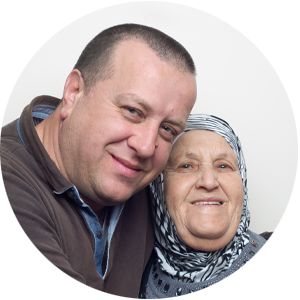What you need to know about getting macular condition treatment in Brooklyn and Manhattan
Are you suffering from a macular condition?
These challenges may sound familiar…


You’re losing your most important sense
You have a macular condition which means your central vision is affected. You may be experiencing blurred or distorted vision, or have lost parts of your vision completely.
Psychological distress
The uncertainty and debilitating nature of this condition can have a detrimental impact on your mental health. Anxiety and depression are not uncommon.
Done with dismal days
Living with a macular condition can dictate daily life. It can prevent you from leaving the house, increases your risk of falls and limits social interaction and independence.
Fight back
It’s time to stop this condition in its tracks. No one deserves to suffer like this. With our range of treatments, we can slow the disease’s progression, preserve existing vision and hopefully recover lost vision. It’s time to regain control.
Macular conditions explained
In these toggles we explain what you need to know about macular conditions
The macula is part of the retina and is responsible for all of our central vision.
There are two important macular conditions:
Age-related macular degeneration (AMD)
This is a common condition that usually affects people in their 50s and 60s.
Symptoms include:
- Blurred or “fuzzy” vision
- Straight lines appearing wavy or distorted
- Blurry areas on a printed page
- Difficulty reading in low light levels
- Extra sensitivity to glare
Macular holes
This eye condition typically affects people aged 60 to 80 and is more common in women than men.
Symptoms include:
- Blurred and distorted vision
- Straight lines appearing wavy or distorted
- Difficulty reading the small print
- A small black patch or missing patch in the center of your vision
- Macular disease affects people of all ages; however, it is often related to the aging process and is most common in people over 50.
Age-related macular degeneration (AMD)
AMD has been linked to smoking, high blood pressure, being overweight and having a family history of AMD. It occurs when the macula starts to breakdown and comes in two forms:
- Wet AMD: This is more damaging and can lead to severe vision loss.
- Dry AMD: This is more common and occurs when the macula deteriorates, causing blurry vision.
Macular holes
We don’t know why macular holes develop. One possible risk factor is a condition called vitreomacular traction which can occur as you get older. The vitreous gel – a natural substance that helps the eye maintain a round shape – starts to pull away from the retina and macula at the back of the eye. This results in a macular hole or tear.
We can diagnose macular conditions by reviewing your medical and family history and performing a comprehensive eye examination which includes the following tests:
- Examination of the back of your eye
- Test for defects in the center of your vision
- Fluorescein angiography
- Indocyanine green angiography
- Optical coherence tomography
- Slit-lamp biomicroscopy
- An indirect peripheral retinal examination
AMD treatment
Depending on the type of AMD you have, treatments may help slow disease progression, preserve existing vision and recover some lost vision if started early enough.
Dry AMD
Currently, there’s no treatment for dry AMD. However, you can slow its progression if you catch it early by taking vitamin supplements, eating healthfully and not smoking.
If your dry AMD is advanced, you may benefit from:
- Low vision rehabilitation to help you find ways to adapt to your changing vision
- Surgery, to implant a telescopic lens which will help magnify your field of vision
Wet AMD
Depending on the severity of the condition, treatment may include:
- Laser treatments
- Intravitreal eye injections
- Eye surgery – Pars plana vitrectomy
Therapies may include:
- Photodynamic therapy
- Photocoagulation
- Low vision rehabilitation
Macular holes treatment
Vitrectomy:
This is where we remove the vitreous gel to prevent it from pulling on the retina. We then insert a mixture of air and gas where the vitreous once was, putting pressure on the macular hole, allowing it to heal.
Ocriplasmin injection:
If the macular hole is caused by vitreomacular traction, it may be possible to treat it with an injection of ocriplasmin into the eye. The injection helps the vitreous jelly inside your eye to separate from the back of the eye and allows the macular hole to close.
Discover your options to get your eyes back in top shape
Call us and we’ll help you take the steps you need to repair your eyes
How to get help
These 3 easy steps allow you to stop worrying about your eyes
STEP 1:
Call us to get an appointment
Give us a call at (718) 630-1010 and we’ll answer the questions you have so that we can recommend the best next step.
STEP 2:
Visit us
Whatever the issue, we’ll provide you with the exceptional care that your most precious sense deserves.
STEP 3:
Get the help you need
Whether it’s a quick intervention or a long-term treatment plan, we’ll guide you with compassion, every step of the way.
Affiliations and memberships
We are proud to be associated with these professional organisations
Got diabetes? Learn how to avoid unnecessary blindness
Discover what you can do to reduce your risk of diabetic vision loss
What our patients say
★★★★★
We’ve been getting 5-star reviews from savvy Brooklynites and New Yorkers for over 20 years


Dr.Khosrof is one of the most knowledgeable doctors in his field. My family and I have been his patients for years and he has never failed to provide us tip top service and always does what’s safest for us and our eyes…


I want to talk about Dr. Samer, he is extremely professional and kind and he has the latest equipment and great staff. He’s very caring about his patients and takes the time to explain.


Dr. Khosrof is an outstanding physician and surgeon with a great bedside manner. As a fellow Ophthalmologist, I have always been impressed by his talent.


Dr. Khosrof improved my eye sight from 20/400 to 20/80. I had previously see 2 other retina specialists and 1 optometrist and none of them were able to help me. He’s terrific!
For more information about macular conditions
Educate yourself further about macular conditions by reading the links below
This link provides an overview of the most common types of macular conditions. Click here to read more.
This link provides an overview of all other types of macular conditions. Click here to read more.
The link contains information and examples of what a macular hole may look like. Click here to read more.
Here is an overview of macular degeneration, its symptoms, causes, diagnosis, treatment and prevention. Click here to read more.
About the expert
Dr. Samer Khosrof | Ophthalmologist
Dr. Samer Khosrof is a top eye surgeon in New York City with over 25 years of experience treating complex eye conditions such as diabetic retinopathy and age-related eye conditions.
His extensive experience enables him to stay on top of the latest treatments available. He believes in the efficacy of medical technology and has the expertise to deploy the newest diagnostic and treatment techniques to treat his patients with 100% confidence.
When you become a New York Eye & Retina Clinic patient; you’re a Samer Khosrof patient first. This means he sees you before your surgery, he performs your surgery, and he provides your aftercare. In the end, you’re his patient, and he takes that responsibility very seriously.
































